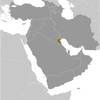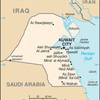Kuwait [+]Compare [E]dit [H]istory
Aliases: Al Kuwayt, Dawlat al Kuwayt, State of KuwaitObject «Kuwait» was created due to
Add new object to «Kuwait» or move existing objects here.
Object «Kuwait» has attributes [Show empty attributes][Hide empty attributes]
| Attribute | Value |
|---|---|
| Geography | |
| Area | 17,818 km² |
| Continent | Asia |
| Land area | 17,818 km² |
| Water area | 0 km² |
| Land boundaries | 475 km |
| Border countries |
|
| Coastline | 499 km |
| Mean elevation | 108 m |
| Lowest point | 0 m |
| Highest point | 300 m |
| People | |
| Population | 2,993,706 |
| Official languages |
|
| Religion | Muslim |
| Government | |
| Long country name | State of Kuwait |
| Short country name | Kuwait |
| Long local name | Dawlat al Kuwayt |
| Short local name | Al Kuwayt |
| Former name | Add |
| Government type | Constitutional monarchy |
| Capital | Kuwait City |
| Economy | |
| GDP (PPP) | 289,700,000,000 USD |
| GDP (OER) | 120,700,000,000 USD |
| GDP (real growth rate) | -3.3 % |
| GDP - per capita (PPP) | 65,800 USD |
| Gross national saving | 35.4 % of GDP |
| Labor force | 2,695,000 |
| Unemployment rate | 1.1 % |
| Population below poverty line | Add |
| Budget revenues | 50,500,000,000 USD |
| Budget expenditures | 62,600,000,000 USD |
| Military expenditures | 5.06 % of GDP |
| Taxes and other revenues | 41.8 % of GDP |
| Budget surplus or deficit | -10 % of GDP |
| Public debt | 20.6 % of GDP |
| Inflation rate | 1.5 % |
| Central bank discount rate | 2.75 % |
| Commercial bank prime lending rate | 4.68 % |
| Stock of narrow money | 33,680,000,000 USD |
| Stock of broad money | 33,680,000,000 USD |
| Stock of domestic credit | 111,200,000,000 USD |
| Market value of publicly traded shares | 81,780,000,000 USD |
| Current account balance | 7,127,000,000 USD |
| Exports | 55,170,000,000 USD |
| Imports | 29,530,000,000 USD |
| Reserves of foreign exchange and gold | 33,700,000,000 USD |
| External debt | 47,240,000,000 USD |
| National currency | Kuwaiti dinars |
| National currency (code) | KD) |
| National currency (symbol) | Add |
| National currency rate to USD | 0.3041 |
Kuwait has been ruled by the AL-SABAH dynasty since the 18th century. The threat of Ottoman invasion in 1899 prompted Amir Mubarak AL-SABAH to seek protection from Britain, ceding foreign and defense responsibility to Britain until 1961, when the country attained its independence. Kuwait was attacked and overrun by Iraq in August 1990. Following several weeks of aerial bombardment, a US-led UN coalition began a ground assault in February 1991 that liberated Kuwait in four days. In 1992, the Amir reconstituted the parliament that he had dissolved in 1986. Amid the 2010-11 uprisings and protests across the Arab world, stateless Arabs, known as Bidoon, staged small protests in early 2011 demanding citizenship, jobs, and other benefits available to Kuwaiti nationals. Other demographic groups, notably Islamists and Kuwaitis from tribal backgrounds, soon joined the growing protest movements, which culminated in late 2011 with the resignation of the prime minister amidst allegations of corruption. Demonstrations renewed in late 2012 in response to an amiri decree amending the electoral law that lessened the voting power of the tribal blocs.
An opposition coalition of Sunni Islamists, tribal populists, and some liberals, largely boycotted legislative elections in 2012 and 2013, which ushered in a legislature more amenable to the government's agenda. Faced with the prospect of painful subsidy cuts, oppositionists and independents actively participated in the November 2016 election, winning nearly half of the seats but a cohesive opposition alliance largely ceased to exist with the 2016 election and the opposition became increasingly factionalized. Since coming to power in 2006, the Amir has dissolved the National Assembly on seven occasions (the Constitutional Court annulled the Assembly elections in June 2012 and again in June 2013) and shuffled the cabinet over a dozen times, usually citing political stagnation and gridlock between the legislature and the government.
Similar objects
Most often compared with
Everyone can something to edit or add.
There was one edit, no edits waiting approval. Last edited by wilkinson.michael(9581), Sep 16, 2019 (61 fields were changed)
Help · Contact us · Disclaimer · Contributors · Developers · Donate


